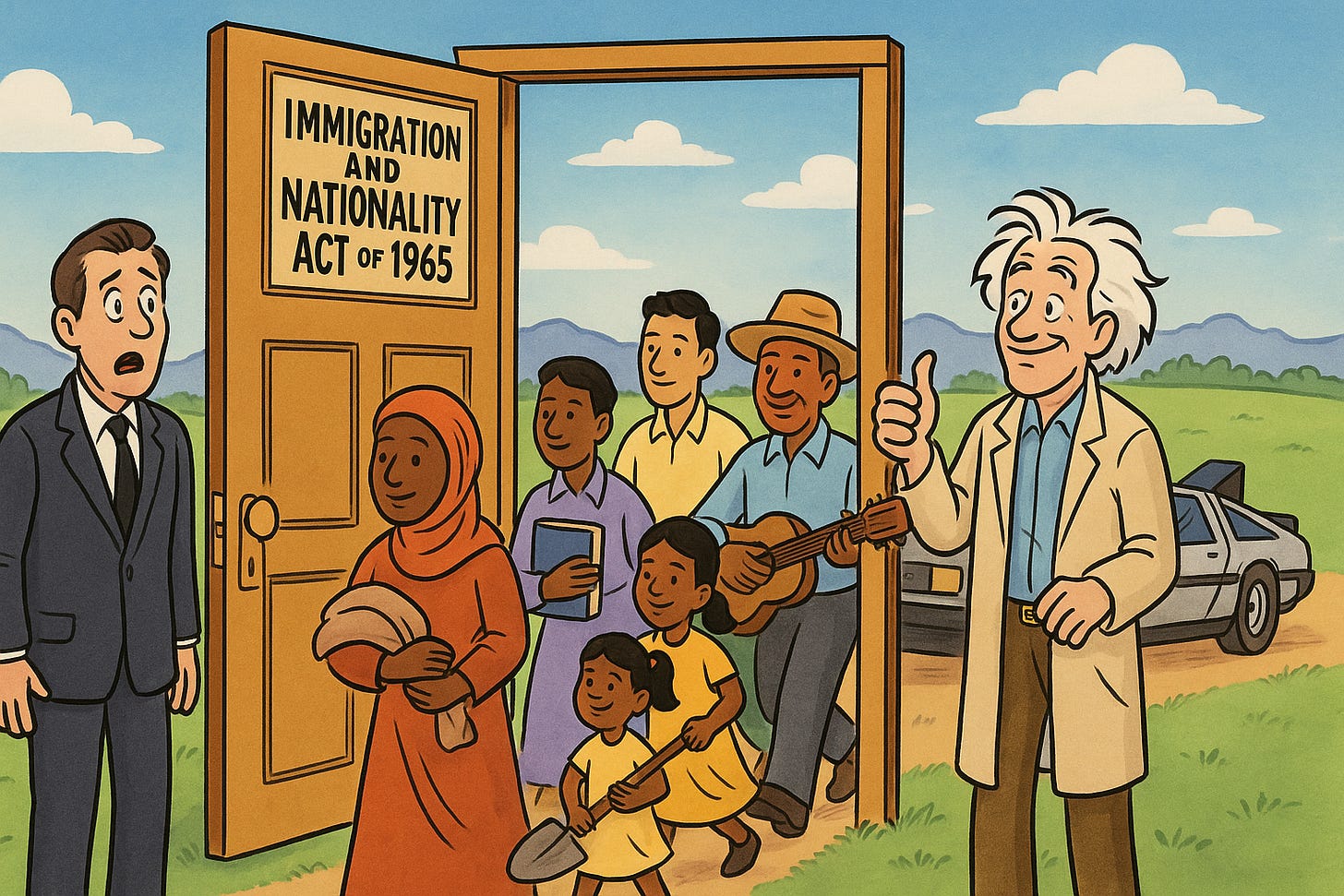Author’s Note: This reflection traces how America’s post-1965 immigration shifts—often passed with little public fanfare—offered a hopeful vision of renewal, yet could not erase the older structures of exclusion and hierarchy embedded in the national fabric. The goal here is not to cast blanket judgment on political factions or generations, but rather to invite a deeper recognition: that true civic maturity requires an honest reckoning with the myths we inherited, the systems we preserved, and the unfinished work that remains.
Coming to terms with our history does not diminish the American story; it dignifies it. It opens the possibility of a country less burdened by denial—and more capable of realizing its highest ideals.

Immigrants in America, no matter how they came, are one of those beautiful traits of our nation that you can reflect on—like a cool spring in the desert—and let cleanse your heart from the hypocrisies and outright lies studying American history often reveals.
Yet even this instinct, sincere and vital as it is, can be manipulated. It can become another way we shield ourselves from reckoning with the full story of America, and from building a political imagination that refuses to revert to comfort and false innocence.
One of my enduring hopes for America was that the recent waves of immigration could help the nation come to terms with—not erase—the systemic destruction faced by Americans of color: Black descendants of slavery, Native peoples confined to reservations, and Mexican Americans displaced after the Mexican War. So many brutal histories get retrofitted into the worn binary of White skin and Black skin, as if the ability—or inability—to "become" White determines one's destiny. Recent immigration from the Global South offered a path out of that trap. A new pattern could emerge.
Immigrants arriving from Asia, Africa, and Latin America brought with them ancient traditions, groundbreaking perspectives, and a richness of experience older than the United States itself.
Their arrival was profoundly shaped by the Immigration and Nationality Act of 1965, a law passed during the high noon of the Great Society. While it formally abolished the racist national origins quotas of the 1920s, the bill was framed at the time as a technical adjustment rather than a transformational shift.
In a Washington occupied by the Vietnam War and the battle for civil rights, immigration reform was a minor chord, not a leading note. Polls from the era show that less than 1% of Americans saw immigration as a pressing issue, and few grasped the law's future implications.1
The legislation passed through the smoky, transactional backrooms of midcentury politics—an elite-driven effort shaped as much by Cold War image-making as by a genuine commitment to racial justice.
It was designed, in part, to counter Soviet propaganda portraying America as a nation mired in apartheid.
At the time, even supporters reassured the public that the new law would not significantly alter the nation's racial demographics. But beneath those reassurances, the seeds of profound change were sown: The slow, inexorable demographic shift that would, decades later, radicalize a critical mass of the American right.
It is no exaggeration to say that much of the cultural and political tension of our era finds its roots here. While the civil rights revolution sought to make America’s founding promises real, a second, quieter revolution was set in motion as faces, languages, and cultures from around the world began reshaping the nation from within.
Yet the political imagination around immigration remained trapped.
Rather than seeing immigration as a chance to reframe American identity—to blend economic and social healing across lines of race and class—too many leaders triangulated. A critical mass within the GOP, beginning in the 1960s, fused white grievance politics with corporate deregulation and national security hawkishness. The Democratic Party, although more inclusive, often prioritized surface-level diversity over structural change, cautious not to scare away suburban moderates, for whom diversity was tolerable as long as it remained symbolic.
Thus, a shallow narrative took hold: That immigrants would redeem the American Dream simply by appearing. That brown and Black faces would fill commercials, classrooms, and suburban cul-de-sacs, allowing the country to believe it had matured without ever truly confronting its history. The wound would be covered, not healed.
That comfortable myth worked—until it didn't.
Today, the mask is slipping. Draconian deportations2, political campaigns built on demographic fear3, and a normalization of indirect, but open, racial dehumanization4 reveal the more profound crisis: For many Americans, the "problem" was never merely unauthorized immigration or economic strain. It was demographic change itself. It was the slow, terrifying realization that America might no longer belong, spiritually or politically, to an imagined, singular "type" of person.
Immigration can paper over an American idiosyncrasy. It cannot heal it.
The first step toward a better country is not a showy repentance born of guilt, but a clear-eyed understanding: America cannot claim to be special while denying its history. It cannot demand belief in myths while refusing to come to terms with how those myths were built—and who was sacrificed along the way.
Immigrants are not here to save America's soul. That work—painful, patient, and honest—belongs to the nation itself.
Pew Research Center, How the Immigration Act of 1965 Changed America, October 5, 2015.
NPR, A 2-Year-Old U.S. Citizen Was Deported to Honduras Without a Hearing, April 26, 2025.
Brian Resnick, The Past Decade of American Life Has Been Defined by Fear, Vox, January 26, 2017.









Although the media and professional pols, say otherwise and keep deflecting Trumps win to "the price of eggs", That which brought him to the Offal Office (that's what his presence has done to that edifice, a White House now an Out House, it is obvious that Trump rode the culture war to power, because that is his prime emphasis his war on woke,, on DEI, on transwomen, on immigrants.
That is his power base.
My thoughts on immigration, is that the real reason behind the position on immigration is race, because Hispanics are culturally conservative, Catholics, Evangelical, Pentecostals, they are, once established and have citizenship, natural allies for Trump's culture warriors.
Por ejemplo Mayra Flores is the Rep of Texas 34 and is an emphatic MAGAt, herself a naturalized former illegal immigrant, she is an adamant anti immigration
Trump and Rhonda Santis power in Florida is in the pan handle (southern Alabama) and in Miami Dade County, among the Bautsitiano caudillioistas, and Venezuelans.